I always have a black hopper fly in my box when fishing on rivers and/or stillwaters because it’s a great, universal fly pattern.
It can be relied upon to catch trout and/or grayling wherever you’re fly fishing and my…
Fly box looks “naked” without a hopper in it.
Generally, a month hasn’t gone by without several trout and grayling being caught on this fly. As such, it holds…
‘Pole Position’ on my list of Top 10 Flies.
So, how to tie my preferred pattern that I use all year round…
How to tie the Black Hopper fly:
Material list:
- Hook: #14 & 12 Kamasan B170
- Thread: 8/0 Uni-black
- Body: Black seals fur substitute
- Rib: Pearl Mylar (1/32″)
- Leg: Knotted black Pheasant tail fibres
- Hackle: Natural hen
7-step tying guide:
I find it works best when the finished fly has a slim profile. Consisting of a sparsely dubbed body and a sparse hackle (2 turns is my preference)…

Step 1. Catch the tying thread onto the hook 2 mm behind the eye. Tie in the pearl Mylar and run the thread in touching turns and stop just past the hook point.
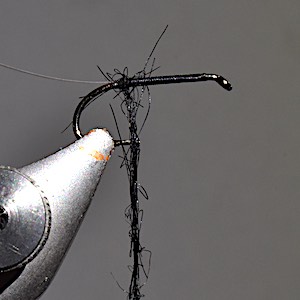
Step 2. Lightly apply dubbing wax to the thread and sparingly dub with the seal’s fur substitute.
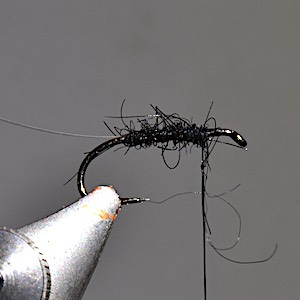
Step 3. Wind the dubbed thread toward the eye leaving ca. 3 mm to tie in the legs and hackle. It’s important to make sure you achieve a slim body profile.
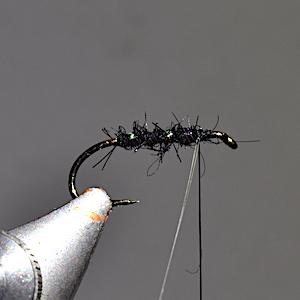
Step 4. Wind the pearl Mylar rib over the dubbing in ca. 4 even turn in the opposite direction to the thread. Then tie off and trim the tinsel waste.
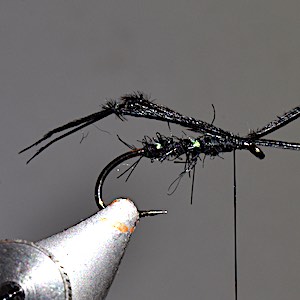
Step 5. Knot and tie in a pair of pheasant tail legs (each leg consist of two knotted fibres) so that they extend past the hook bend. Trim the waste ends.
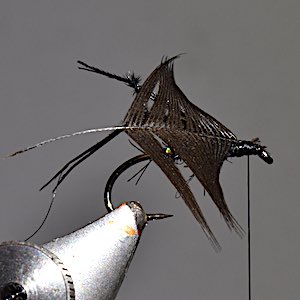
Step 6. Prepare the natural black hen feather and tie it in by its tip
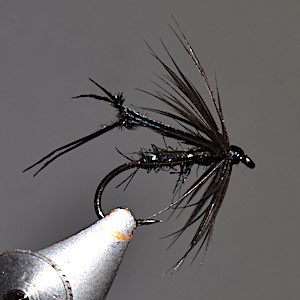
Step 7. Using hackle pliers make 2.5 turns, secure the hackle with the thread, and build a small head. Whip finish and coat with varnish
How to fish the Black Hopper fly:
On rivers, I normally fish the BH wet when prospecting for trout and/or grayling through glides and pools when there is no evidence of fly hatching.
Normally, I will fish the BH on the middle dropper or the point on a team of three wet flies with a March Brown spider and Iron Blue wet fly on the other dropper positions.
Equipment-wise I use a 9ft 5# fly rod loaded with a floating line, and a 9ft 5X copolymer leader, which has been cut back to 5ft from the butt end. At the end of the leader, I tie on two 3ft lengths of 3lb copolymer to form 2 droppers.
In April and May, trout can become transfixed on taking when Hawthorn flies that have been blown onto rivers and lakes. When that happens, fishing a BH on or just under the water surface can produce some excellent sport.

Later in the year, brown trout on the Welsh Dee probably mistake a hopper for a fry when fishing it wet in the margins of pools in the evening.
For more on fishing wet flies check out the following link on the…
Beginners guide to wet fly fishing
On lakes and reservoirs, the BH catches trout in the margins when they are feeding on heather flies or fry and in open water during a buzzer hatch.
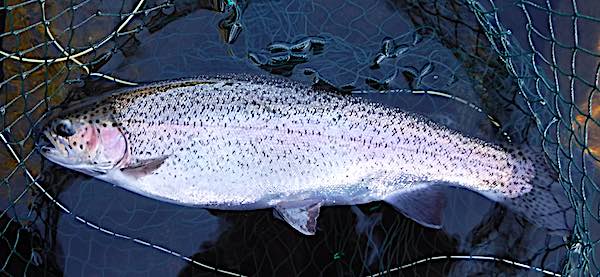
Finally, I hope this article on tying the black hopper fly stimulates you to test it out on your local river, lake, or reservoir.
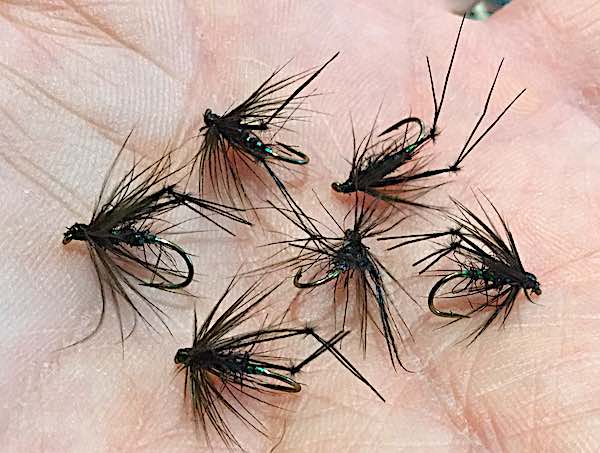
very good i do like to fish with the black hopper
very well done
Cheers, glad you enjoyed the post
Thanks for the tutorial. Will tie some for use in East Texas ponds as I suspect our sunfish and bass will take this fly readily.
Hi Paul,
I hope they work in your ponds. Would be great to hear about what they catch.
Cheers, Andrew
Great article Andrew that fly would catch fish in a damp sponge. North Wales trout are hot wired into black patterns aren’t they, my favourite Brenig set up was 2 black pennels one 12 the other 16 and a black hopper on the drop caught from the surface to the bottom all season
Hi James,
Thanks for the comments on your favorite fly set-up for fishing Brenig. Hopefully, I will be able to fish there next year and give it a go. Will also try that combination on Trawfynydd.
Cheers, Andrew
Great article Andrew I enjoy reading your tips thanks
Hi Richard,
Great to hear you’ve enjoyed the article.
Cheers, Andrew
You may find using a small crochet hook to knot the pheasant tail legs is a good method!
Hi Mike,
Thanks for the tip, will have to give that a go. I just use a pair of hackle pliers to grip the tips of the fibres and tie the knot.
Cheers, Andrew
What are the best flys for this time of year on Reservoir
Hi Mark,
Unfortunately, I’m not the best person to ask that because I don’t fish reservoirs in winter because I’m normally grayling fishing. I would suspect it will be lured and fry patterns. Attached is an article on the subject you might find useful https://blog.fullingmill.com/best-6-stillwater-fly-patterns/ and https://magazine.anglingactive.co.uk/winter-trout-fly-fishing-tips/
Cheers, Andrew
Nice tutorial and good explanation. Love it
Hi Geert,
Thank you for the feedback and I’m pleased you enjoyed the post.
Cheers, Andrew
This is a cracking little fly and also a good little attractor of white trout from the rivers and lakes in Donegal, 10-14 seem to work best for me.
Btw all these blogs are excellently written, highly informative both technically and particularly on the ‘how to fish pools” section. I have not seen this level of detail before.
Great work.
Hi Mark,
Thank you for the feedback on the articles I’ve been writing – it’s great to know that you have found them interesting. The black hopper fished wet is a great all-round fly pattern on wild rivers because terrestrial flies form a significant part of a trout’s diet.
The how to fish pools are designed to help visitors fishing the river get the most out of their fishing trip. Writing them has also helped me think about how I fish each of the pools from a different angle and I have learned a few new things.
Cheers, Andrew
very good article good information
nicely done
Thanks
Hi Andrew,
Is it possible to\reasonable to fish Hoppers as a dry fly ?
Best
David
Hi David,
Black hoppers are usually tied as dry flies using a cock hackle. This wet version is tied with a hen hackle.
I hope this helps, Andrew
Hi Andrew, I agree that it is a great all round pattern and thank you for providing your tying of this fly. Tight lines, Iain.
Hello Andrew,
Black Hopper looks really useful.
Started looking for best way to form the legs.
Discovered ‘THE DADDY TOOL Knot Tyer Video Tutorial.’
Advertised in Trout and Salmon magazine, Trout Fisherman Magazine, etc.
Of interest because it forms the leg knot very open allowing the knot to be adjusted on a pin to any position on the leg, close together for size 12, further apart for our cicada tied on a 6.
Have you seen this tool, I would like to buy one.
Best regards,
Lindsay Coles.
From New Zealand.
PS, I enjoy your articles very much.
Hi Lindsay,
The black hopper is a very versatile fly that fools trout on rivers and lakes. I just knot the legs by hand using a pair of hackle pillars, so can’t help you with the tying tool. However, I did come across a video that shows you how to use a paperclip to tie legs https://www.youtube.com/watch?v=YgdiytqW9J8
I hope this is helpful, Andrew